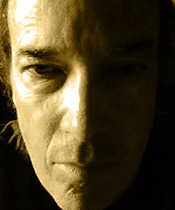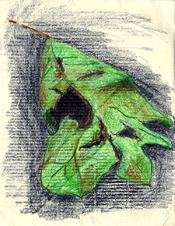Sunset, Sunday, 20 September 2009
 William Theodore Van Doren. Stony Point, Albemarle County, Va. Oil on paper, 16 x 20.
William Theodore Van Doren. Stony Point, Albemarle County, Va. Oil on paper, 16 x 20.
This is what they call ‘Mostly Cloudy’.
Sometimes I wonder what Thoreau would have done, or how he might have done, if he’d been in the position of issuing blog postings every day from Walden Pond. I mean, wouldn’t there have been quite a few days when he would have been unable to think of anything more to say than “Jesus, it’s cold!” or “Harvested 3 bu. beans ... swam across pond ... listened to bullfrogs”?
Henry David strikes me as the deliberative sort, probably not the easiest or most fluid of writers. He wrote about half of Walden while he was living at the pond, between 1845 and 1847, but then went through seven drafts before publishing the book in 1854. As you probably know, it was a failure, commercially.
But I do wonder also if it might not have helped Thoreau to have the kind of daily imperative to communicate that many of us feel today. Thoreau took time to distill and compress, and in a sense elevate, his experiences into the book so many have come to know. But he also said, after Walden was published:
Is not the poet bound to write his own biography? Is there any other work for him but a good journal? We do not wish to know how his imaginary hero, but how he, the actual hero, lived from day to day.
I am happy to know that Thoreau could write this even as he was sitting in a house filled with unsold books. But speaking for myself, I know that if I’m a hero, it’s only in my own mind, and so I am strictly my own imaginary hero. And I find that learning how to write a ‘good journal’, and particularly to both write and publish in real time, can be extremely challenging. Those who can do it – hello again, Stephen Fry, Andrew Sullivan, James D. Griffioen, among others – these may be poetic heroes for our time.
 Sunday, September 20, 2009 at 08:10PM | by
Sunday, September 20, 2009 at 08:10PM | by  BVD | in
BVD | in  A Painting A Day,
A Painting A Day,  Sunset Paintings | tagged
Sunset Paintings | tagged  Andrew Sullivan,
Andrew Sullivan,  Henry David Thoreau,
Henry David Thoreau,  James D. Griffoen,
James D. Griffoen,  Stephen Fry,
Stephen Fry,  Walden,
Walden,  writing | | Comments Off
writing | | Comments Off 





Sunset, Friday, 24 July 2009
I got introduced lately (thanks to Aime Ballard-Wood) to a superfine blog called Sweet Juniper! (exclamation mark theirs, not mine, although ... I would have been happy to add one). I really don’t think I’m the last person in the world to find out about it, quite.
I’ve only scratched the surface of this rich rich site, but I think it’s written and photographed by James D. Griffioen, with occasional posts by his wife, who pens under the name Wood. I love the blog’s sensibility, the flowing and wide-ranging connections it makes, the feeling that there’s so much creative energy, love, irreverence, reverence and intelligence behind it that anything can and probably will happen.
Before I mention the thing that got me going today, I want to recommend posts on alphabet books JDG has made for his kids – this very funny account of his book of Greek letters contains links to the others – and to second his enthusiasm for the group Heartless Bastards. The two videos he posts from SXSW should win you over.
Feral houses. That’s what Griffioen calls abandoned houses that are overgrown and falling apart. He lives in Detroit, so he’s ‘got a million of ’em’ – and seemingly almost that many photographs, of houses and amazing larger buildings, even an abandoned zoo.
I won’t try to recap his riff on why these houses are ‘feral’ – except his comment that they’re returning to a wild state made me think about the attraction ruins have always had for artists, whether it’s someone like my man Corot going off to Rome or your grandpa painting an old barn. It occurred to me that I’ve never read anything about the source of the appeal. (That’s probably because I don’t get around much – seriously.) But I guess it’s just sort of assumed that these places are obviously ‘picturesque’ and/or, maybe, that their association with the past makes them ‘romantic’.
As Griffioen says, these houses start to return to nature:
For a long time, I’ve thought the artistic appeal of ruins was simply that: they become more integrated with the environment, they show a natural process at work. Now I see two other related aspects.
First, the art process, by definition, tends to unite anything it renders, such as any building, old or new, with everything else around it – that’s in the nature of style. Ruins are great because they’re already halfway there.
Second, a ruin contains time.
So, strange to say, even though it’s about the past, and time, it’s not about what the buildings once were. It’s all about what they now are.